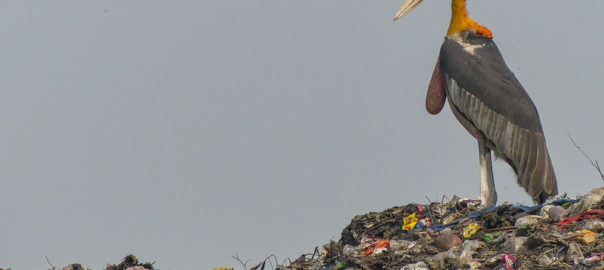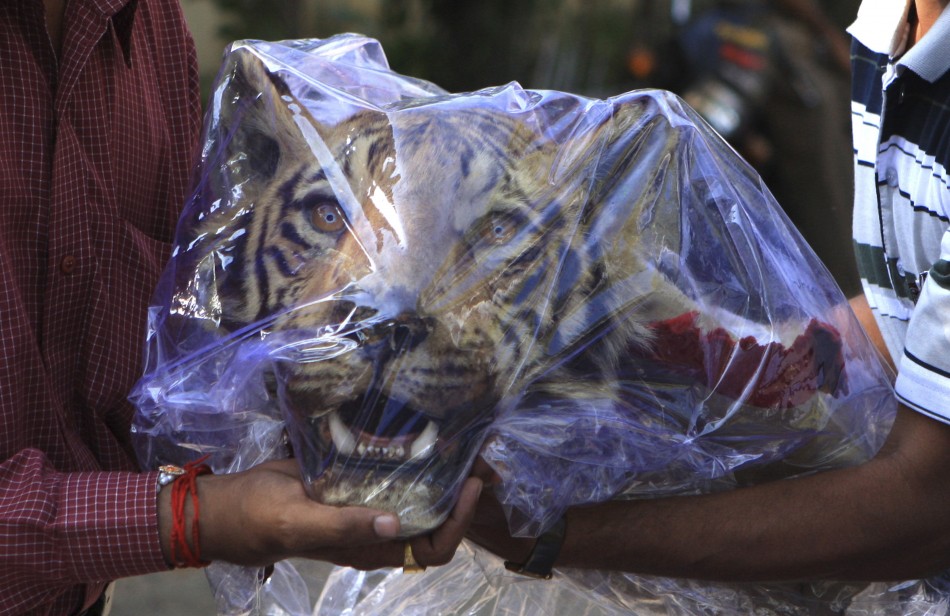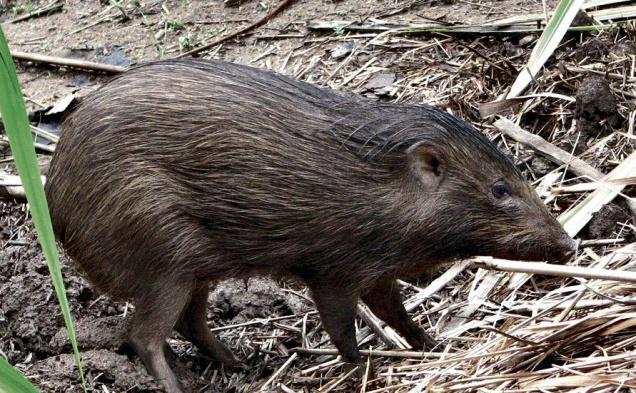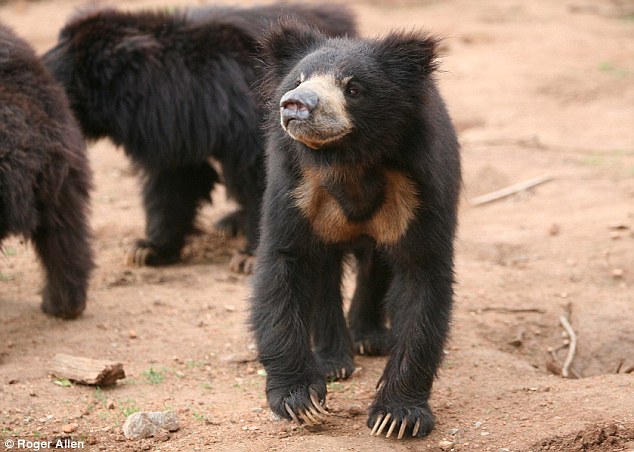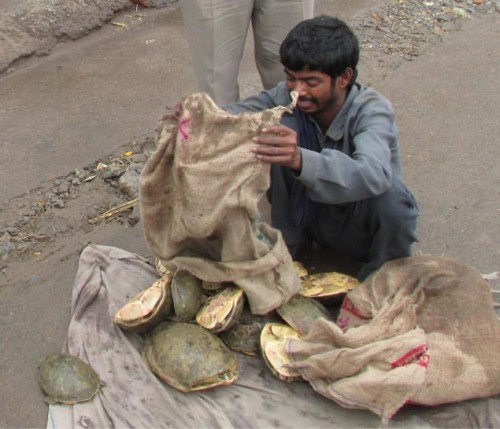On a bamboo platform 10 feet above the ground, a baby stork is safely nestled and busy getting much attention and care from its parents. Keeping an equally watchful eye are a group of zoo authorities of the Assam State Zoo observing the family from down below. They have waited with batted breath for this particular moment for years. After all, it is not every day that one of the rarest storks in the world is born in captivity.
The Greater Adjutant Storks (Leptotilus dubius) or the Hargila is a large bird, like many others of the stork family. An adult stands at 154 -150 cm with a wingspan of 250 cm. Red or pink-skinned neck bare of feathers gives it a vulture-like appearance. This is an adaptation as the Adjutant also feeds on carrion and feathers could become messy as it pokes into decaying flesh.
During breeding season this neck region becomes bright orange. The bill is massive and wedge-shaped and is used as a means of communication when the birds make a bill clattering sound during the breeding season. It also grunts from time to time.
The hargila loves to forage around drying pools and wetlands, waiting to catch fish, frogs, crabs, lizards, snakes and even chicks of other wetland birds. At one time it was commonly seen in wetlands of the Indo-Gangetic plains, as well as plains from Pakistan to Burma. It is also found near garbage dumps where carcasses of animals would be discarded earlier. In fact, the term hargila in Bangla means ‘feeding on bones’. This behavior is not unusual and is akin to the Marabou storks found south of the Sahara which is why both the storks are categorized in the same stork family of Ciconiidae.
The Hargila at one time was such a common bird in Bengal and other eastern states of India that it also got the distinction of being used on the erstwhile Calcutta Municipal Corporation logogram. The birds were respected for providing valuable “janitor service” within the urban landscape and were also called the “Calcutta Adjutant”.
Read More: 20 Greater Adjutant Stork Found Dead in Assam
Rapid Decline
With wetlands being drained for agricultural lands and logging of tall trees which used to be their nesting niches, the range of these majestic birds declined along with their population. Habitat destruction, pollution and expansion of human settlements into rural areas, added to their troubles.
Soon from a population spread over entire southeast Asia, the adjutant stork’s population restricted to a mere thousand found only in Assam and Bihar in India and in Cambodia. The IUCN Red Data List tagged them as “Endangered”. In 2014, the Zoological Society of London labeled the birds as “Evolutionary Distinct and Globally Endangered” or EDGE species, which means they are close to extinction.
At present, most of the birds are seen in nesting flocks on privately owned property and in villages within Assam and Bihar. They are also found on dumping grounds, because that is the only place where they can find edible things amidst the waste. This makes conservation challenging as there are no protected areas (PAs) allocated for them.
And yet, some individuals like Purnima Devi Burman and Arvind Mishra have made it their life’s mission to save the birds.
Helping hands
In November 2019, for the first time in years, the Assam State Zoo & Botanical Garden in Guwahati in collaboration with the conservation organization Aaryanak was successful in ex-situ breeding of the Hargila. A chick was born on 26th November and another followed ten days later. This programme was initiated based on the field study conducted by Dr. Purnima Devi Barman.
Also Read: From Loathed to Loved, Villagers Rally to Save the Greater Adjutant Stork
As a young girl living in rural Kamrup District, in the Brahmaputra Valley, Purnima found that hargilas nested in tall trees and fed on almost everything that was found to be around from carcass to animal refuse. She noted that the locals loathed it and would fell the trees where there were nests, since it would “rain” down a lot of poop!!
She started a public awareness education programme on the need to protect the trees and thus enabling conservation of the Hargila. She also conducted school outreach activities on World Wetland Days and rescued fallen chicks from nests. These fledgling birds were kept in the Guwahati Zoo before release into the wild.
Meanwhile, in another part of the Hargila landscape Arvind Mishra working with the Indian Birds Conservation Network, was trying to save this species in and around Bhagalpur district in Bihar which also happens to be a breeding zone for these birds. In his community-level conservation approach, Mishra addressed the issue by connecting the bird with the mythological Garuda and was able to convince the local people from disturbing nesting individuals and ensuring that trees were not cut down. According to his estimates there were about 70 odd birds in 2007 which increased to 500 at present.
In Assam, Purnima established a cadre of women Self Help Group (SHG) which is also into conservation besides social marketing of handwoven gamochas or scarfs and other handloom products. Her SHG is referred to as the Hargila Army, consisting of 400 women from Dadara and Pacharia villages. As of 2019 there are about 200 hargila nests from these villages looked after by the Hargila Army.
Also Read: Here are the 8 natural world heritage sites of India
Aping the natural nests
In the wild, the nests of the stork are constructed on top of lofty trees which have a wider canopy with less leaves to facilitate taking off and landing. Such preferred trees are Kadam (Anthocephalus cadamba) and Blackboard Tree (Alstonia scholaris) and are found in Indo – Gangetic plains. The nesting materials used are locally found twigs and sticks and several pairs are known to nest in selected trees, almost like a heronry. Females usually lay 2-3 whitish eggs and both parents are seen to incubate. Chicks hatch after 28-30 days of incubation. The female is seen spreading its wing to protect the chicks from harsh sunlight or rain. In about four months young birds area seen flying around the nesting trees.
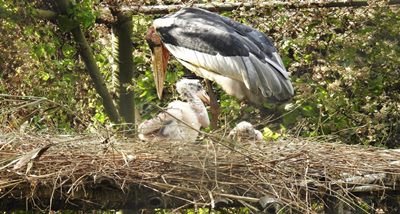
Purnima initiated construction of bamboo towers and platforms to enable these birds find a nesting habitat as close to their nesting areas around these villages. Such bamboo platforms were also ideal to study the nesting behavior of these birds.
At the Assam Zoo, similar bamboo platforms were set up. The enclosure in which these birds were kept was supplied with nesting materials which were more or less of the same materials found in the wild.
The birds nested from 2017 but eggs failed to hatch. Success eventually came after two years of persistent efforts when the two hatchlings emerged. This was mainly due to the active support of Tejas Mariswamy, DFO, veterinarian Dr. Bijoy Gogoi, animal keepers Rajani Kanta Deka and Basumatary.
This captive breeding has shown that species on the brink of extinction could be revived through scientific ex-situ projects. Hopefully, in the near future, we will be able to see the soldierly steps of the Greater Adjutant in and around the wetlands of Assam and Bihar.
Featured Image courtesy Mike Prince via cc/Flickr

